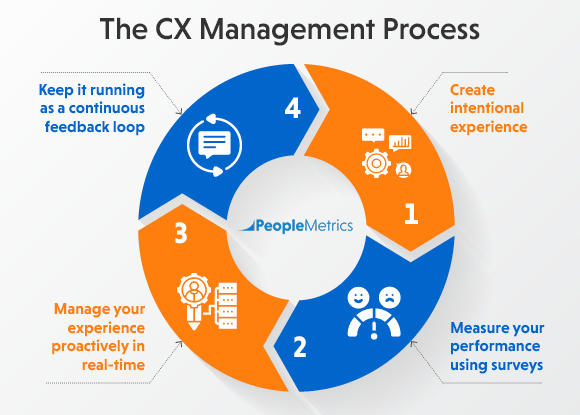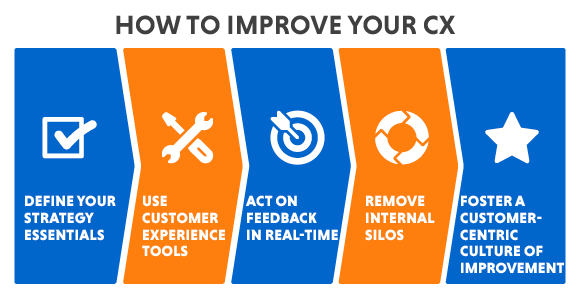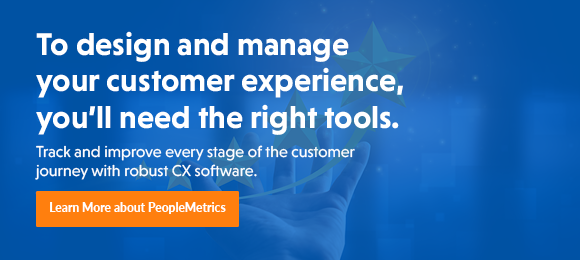Customer experience (CX) has become an essential cornerstone of modern business strategy. It helps you improve customer retention rates, efficiently focus on your highest-impact customers, and continually improve your services. Developing a world-class CX strategy is well worth the investment of your time!
But what is customer experience? How do you design and manage a CX strategy? How do you get started?
This complete introduction to CX will review everything you need to hit the ground running:
- Customer Experience FAQ
- Benefits of Customer Experience
- The Customer Experience Management Process
- How to Improve Your Customer Experience
- What You Need to Get Started
Frequently Asked Questions about Customer Experience
Let's start by reviewing the fundamentals. These are the most frequently asked questions about customer experience.
What is customer experience?
Customer experience (CX) is the concept that all of the touchpoints between a business and its customers contribute to the customer's overall impression and emotional connection to the business. This connection is a critical factor in driving customer retention and net promoter score improvements over time.
CX encompasses every interaction across all stages of the customer journey, from discovery and awareness to decision-making, transactions, and retention.
What is customer experience management?
Customer experience management is the process of intentionally creating, continuously tracking, and proactively managing the customer experience. In other words, it's how businesses put the core concepts of CX into action.
At the day-to-day level, an effective CX management process allows you to tailor the experiences of your highest-impact customers, as well as to proactively reach out when any customer experiences a negative interaction.
Over the long run, collecting feedback at critical points in the customer journey gives you the data and insights you need to make strategic and iterative improvements to your service.
What is a customer feedback loop?
A CX process generates data and insights through customer feedback loops. These cycles involve a few steps:
- Identifying a touchpoint or customer problem to study
- Collecting customer feedback about that touchpoint
- Making strategic improvements based on customer feedback
- Tracking changes in the feedback and making more iterative improvements over time
This continuous process, supported by a robust CX strategy, surveys, customer advisory boards, and other tools, allows you to continuously monitor the impacts of your improvements and make targeted changes over time.
How is CX different from customer service?
Understanding the difference between CX and customer service (CS) is vital for creating an effective CX strategy.
- CX refers to the sum of a customer's interactions with your company.
- CS refers specifically to the process of helping to solve customers' needs and problems, oftentimes after that problem has already occurred.
Think of CS as a part of a complete CX journey. Some touchpoints (like calling your support line to ask questions) involve customer service while others (like using your website to learn more and make a purchase) do not.
An effective strategy takes both types of touchpoints into account, including those that do not involve direct interactions between customers and your employees.
How is CX different from market research?
In the context of large-scale marketing and product development strategies, the difference between CX and market research is also important to understand.
- CX involves continually gathering feedback from all customers and allows for individual two-way communication to learn more and resolve issues.
- Market research is time-bound and focuses on specific strategic questions through surveying small samples of customers and one-way communication.
Depending on the exact context in which they're being used, these are often fully separate processes. In some situations, however, companies are seeing incredible results and increased efficiency by periodically inserting their market research questions into continuous CX feedback collection cycles.
How is CX management evolving today?
The field of customer experience is constantly evolving alongside the broader business environment. Here are a few trends we're seeing:
- Increased investments in AI technology, like text analytics and automated service recovery, to streamline elements of the CX process.
- A subsequent leveling of customer experience across all segments (despite their varying expectations and value for your business).
- The continued convergence of CX and market research as organizations embrace the continuous feedback model of CX.
At PeopleMetrics, we see these trends building towards a new frontier in CX: high-impact customer experience—learn more below.
The Benefits of Customer Experience
Implementing a robust customer experience strategy brings your business a range of significant and interrelated benefits:
- Deeper and more valuable insights
- CX gives you much more insight into the customer journey, including pain points or "moments of truth" that need addressing. Sporadic feedback collection or customer service aren't enough to generate truly holistic data.
- Data-driven improvements and KPI results
- A CX management strategy gives you the data and structure you need to strategically improve customer retention, net promoter scores, and lifetime values through iterative, data-backed changes.
- Improved brand loyalty and reputation
- By consistently and intentionally rooting your improvements in customer feedback, you can see increased brand loyalty and attachment over time. CX will also help to foster a collaborative, customer-first culture at your business that will further support your goals over the long run.
- More touchpoints for actively improving customer experiences
- Since a CX strategy involves frequently gathering customer feedback, you'll create additional touchpoints in which you can identify negative experiences in real-time. This means you can actively reach out to resolve customer issues before they decide to contact you or, worse, churn.
CX Management and High-Impact Customers
As mentioned above, we see high-impact customer experience as the newest field of customer experience management.
Your high-impact customers are those who generate the most value for your business, and they often have higher expectations than your average customer. They warrant personalized attention, fast responses, and white-glove experiences.
With the rapid rise in popularity of AI technologies to streamline customer service and feedback analysis, companies actually face a new risk of flattening all of the experiences they offer to customers. So while a standardized, top-notch customer experience is hugely beneficial, experiences that are too standard across all segments can risk alienating some of your most important customers.
A solid CX management process and the right tools allow you to closely track all touchpoints with these customers and reach out as soon as they're ready to take the next step. CX gives you the structure needed to proactively tailor the experiences of your highest-impact customers.
If you're new to CX and unsure where to start, we recommend focusing first on the places where your efforts will have the greatest potential impact—your interactions with high-impact customers.
The Customer Experience Management Process
So what does the customer experience management process look like in practice? We break it down into four key steps:

- Create intentional experiences. Define the specific experiences, touchpoints, or "moments of truth" in your customer journey that you want to learn more about and improve.
- Measure your performance using customer surveys. What do customers think about the current state of the experience or touchpoint? Use CX software like PeopleMetrics to facilitate targeted surveys and streamline analysis.
- Manage your experience proactively and in real-time. Use incoming survey data to reveal individual customer issues that need to be resolved. As you generate more data, look for trends. By implementing improvements or changes based on these findings, you can begin proactively strengthening the experience.
- Keep it all running in a continuous feedback and data collection loop. Set your CX cycle into motion, continually collecting new feedback as your make iterative improvements to touchpoints across your entire customer journey!
This core structure, supported by software designed for collecting data about customer satisfaction and other touchpoints, will give you a stable foundation on which to start perfecting your customer experience.
Essential Elements of a Customer Experience Strategy
The central CX process and feedback loops themselves are relatively straightforward concepts. However, when developing a customer experience strategy, you'll encounter other elements that might need more explanation. Here are a few of the most important concepts to keep in mind:
Customer journey mapping
A customer journey consists of all the touchpoints, both direct and indirect, that a customer has with a business over time, starting with initial awareness or discovery of its product or service and ending in a cycle of long-term engagement and repeat transactions.
Mapping out the journeys that your own customers take with your business is an essential part of CX strategy. Learn more with our complete guide to customer journey mapping and free template.
"Moments of truth"
Moments of truth, also called pain points, are crucial touchpoints in your customer journey.
These junctures have particularly high stakes. If the interaction goes well, the customer will be satisfied with your service and feel an emotional connection to your business. If it goes poorly for whatever reason, the customer could churn or even spread negative word of mouth.
Moments of truth are the most important places to begin improving your CX through feedback collection and iterative improvements.
Voice of Customer (VoC) or customer listening
Voice of customer refers to the aggregate picture of your customers' expectations, preferences, dislikes, and feedback over time. A VoC program collects, studies, and analyzes this information to help guide strategic decisions.
Customer feedback from CX surveys, post-transaction reviews and recommendations, market research, web analytics, industry benchmarking data, and more are all common VoC channels for collecting data.
How you approach CX and VoC will vary depending on your business context. For example, B2B and B2C voice of customer programs have several critical differences to understand as you start collecting data.
CX metrics and KPIs
CX metrics and key performance indicators are a must whenever you kick off a new CX improvement or initiative. A few common examples include:
- Net promoter score (NPS)
- Customer effort score (CES)
- Customer satisfaction (CSAT)
- Segment-specific metrics, like NPS or CSAT among a defined segment of high-impact customers (HIC)
This PeopleMetrics guide to CX metrics covers a few of the most important CX metrics in greater depth.
It's essential to understand and define your CX metrics because they will give you reference points by which to gauge your performance over time. PeopleMetrics CX software will track your specified KPIs over time and generate automated reports to show you the most important trends at a glance.
How to Improve Your Customer Experience
Now it's time to put all the pieces together. How do you improve your customer experience and build an effective CX management process? We have a few tips:

Define your CX strategy essentials.
Start by nailing down the specifics of what you're aiming to accomplish. We recommend answering these questions and using them to shape your strategy from the very start:
- Why - What are your CX goals? What KPIs will you use to track your progress?
- Who - Who are your target customers? Are there particular segments whose experience you want to improve?
- When - When do moments of truth occur in your customer journeys?
- How - What will you need to execute the strategy? For instance, you'll likely need a certain volume of survey responses, the ability to take individual and aggregate actions, and data accessibility across teams.
Use CX tools that make continuous iteration easy.
Dedicated software is a must for conducting a CX strategy at scale. Platforms exist for collecting and measuring customer satisfaction data, but the complete CX picture requires more than just post-transaction feedback.
Use robust CX software (like PeopleMetrics) to capture the voice of the customer and compile data for analysis at all stages of the customer journey.
Act on feedback in real-time whenever needed.
One of the biggest benefits of using CX software and continually collecting customer feedback is that you can flag customer issues in real-time. This is particularly valuable for stewarding the journeys of your highest-impact customers.
When negative feedback flows in, make sure you have protocols in place for quickly passing it to the relevant team in your organization. They should then take immediate action to close the loop by correcting the issue or reaching out to the customer for more information.
Remove internal silos that impede improvements.
In the example above of addressing negative feedback in real-time, success hinges upon being able to share the feedback internally and having a clearly defined reporting process.
The same best practices of feedback management apply to your bigger-picture CX improvements. Removing internal data silos and empowering your teams to take action can unlock significant CX results for your organization. Ensure that relevant teams have appropriate access to your CX data and reports. Your software should include fine-tuned permissions options.
Foster a customer-centric culture of continuous improvement.
To maximize the impact of your CX strategy, it needs to be supported by more than just data and software.
A customer-centric internal culture and an emphasis on collaboration and continuous improvement will be invaluable. There are a few things that can help:
- Removing internal CX data silos
- Creating team-wide goals around CX metrics
- Frequently recognizing and celebrating CX and customer satisfaction wins
- Clearly tying your CX successes to broader business success
- Encouraging employee feedback, input, and insight sharing
What You Need to Get Started
So what do you need to get started developing a customer satisfaction strategy? To recap, here are the essentials:
- The right technology, ideally including CX software, a central CRM or database, and any other customer outreach platforms that you're already using.
- An initial idea of what you want to learn and/or improve about your customer experience.
- An understanding of your customers' voice, including their needs and priorities, as well as how these vary between segments.
- Open lines of communication across teams that play in role in the ultimate experience offered to customers.
Remember that customer experience management is all about discovery and iteration—when you're equipped with the right tools, understand the CX process, and are eager to learn and improve, you're already set up for success.
And CX will only become an increasingly important part of well-rounded business strategies as the landscape and customer expectations continue evolving both on- and offline. Looking ahead, it's clear that stellar customer experiences and white-glove attention for high-impact customers will be key differentiators of leading 21st-century businesses.
Think of it this way: Your customer feedback is a goldmine, and CX is how you tap into it. By using robust CX software like PeopleMetrics, developing intentional CX feedback loops, and continuously tracking your performance, you can start to see some incredible results.
Want to learn more? Shoot us a message! We'd love to help. Or keep exploring with these additional PeopleMetrics resources:
- 3 Strategies for Turning Your Customers into Promoters
- 5 Secrets Behind World-Class Customer Experience
- How to Optimize Your CX Surveys with SMS and Video Feedback
- 3 Ways to Align Customer Experience and Market Research







%20(1).png)